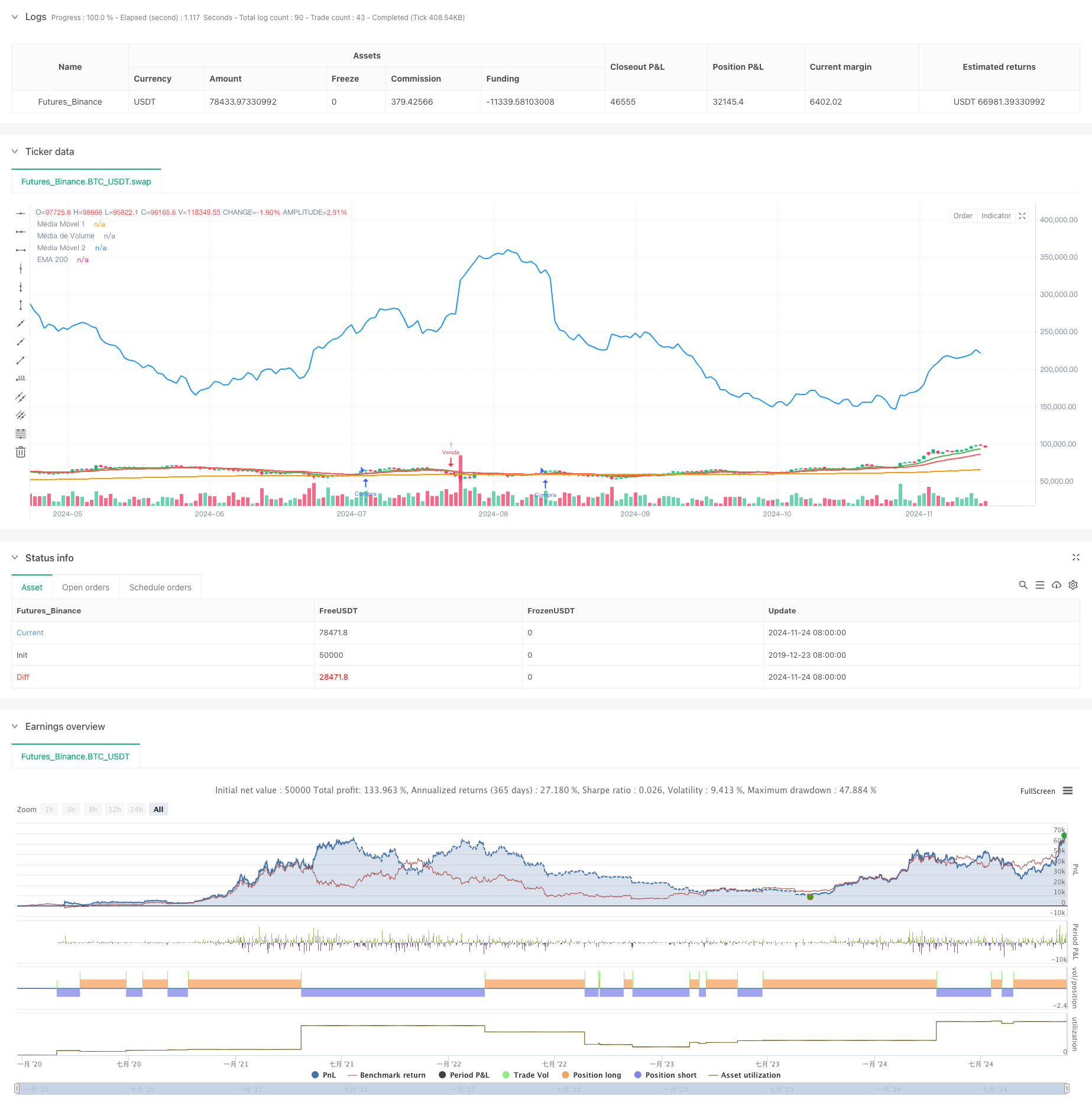Multi-Period Moving Average Crossover with Volume Analysis System
Author: ChaoZhang, Date: 2024-11-27 15:08:39Tags: EMASMAWMAVOL

Overview
This is a quantitative trading strategy system based on moving average crossover and volume analysis. The strategy makes trading decisions through crossover signals of various types of moving averages (including EMA, SMA, and WMA), combined with volume indicators. The system supports flexible configuration of moving average types and parameters, while introducing volume analysis as a trade confirmation condition to improve reliability.
Strategy Principles
The strategy uses a dual moving average crossover system as the core trading signal, combined with volume analysis as auxiliary judgment:
- Uses two moving averages (MA1 and MA2) of different periods, supporting free switching between SMA, EMA, and WMA.
- Introduces Volume SMA as a volume reference standard.
- Uses 200-period EMA as a long-term trend judgment benchmark.
- Generates long signals when the fast MA crosses above the slow MA with volume above its average.
- Generates short signals when the fast MA crosses below the slow MA with volume above its average.
Strategy Advantages
- High Flexibility: Supports multiple MA types to meet different trading style needs.
- Reliable Signals: Improves signal quality through volume confirmation.
- Trend Following: Incorporates long-period EMA to avoid counter-trend trading.
- Adjustable Parameters: MA periods and volume periods can be flexibly adjusted.
- Systematic Operation: Clear trading rules, minimizing subjective factors.
Strategy Risks
- Consolidation Risk: May generate frequent false breakout signals in sideways markets.
- Lag Risk: Moving averages have inherent lag, potentially missing optimal entry points.
- Cost Risk: Frequent trading may lead to high transaction costs.
- Market Environment Dependence: Strategy effectiveness heavily relies on trend strength.
Optimization Directions
- Add Trend Strength Indicators: Consider adding ADX for trading only in strong trends.
- Optimize Stop Loss: Implement trailing or fixed stop loss for risk control.
- Enhance Market Cycle Analysis: Incorporate volatility indicators for parameter adaptation.
- Improve Volume Analysis: Add volume pattern recognition for better signal quality.
- Implement Risk Control: Set maximum position limits and daily stop loss limits.
Summary
This is a quantitative trading strategy combining classical technical analysis theories through moving average crossover and volume analysis. The strategy design is reasonable with strong practicality and scalability. Through parameter optimization and module enhancement, the strategy’s stability and profitability can be further improved. It’s recommended to conduct thorough backtesting before live trading and adjust parameters according to specific trading instrument characteristics.
/*backtest
start: 2019-12-23 08:00:00
end: 2024-11-25 08:00:00
period: 1d
basePeriod: 1d
exchanges: [{"eid":"Futures_Binance","currency":"BTC_USDT"}]
*/
//@version=5
strategy("Cruzamento de Médias com Volume ☾︎ 𝔇𝔞𝔯𝔎 ✞︎ 𝔗𝔯𝔞𝔡𝔢𝔯 ☽︎", overlay=true)
// Criação de opções no editor para selecionar o tipo de média móvel
maType1 = input.string(title="Tipo de Média Móvel 1", defval="EMA", options=["SMA", "EMA", "WMA"])
maType2 = input.string(title="Tipo de Média Móvel 2", defval="EMA", options=["SMA", "EMA", "WMA"])
// Função para selecionar a média móvel de acordo com o tipo escolhido
getMovingAverage(maType, src, length) =>
if maType == "SMA"
ta.sma(src, length)
else if maType == "EMA"
ta.ema(src, length)
else if maType == "WMA"
ta.wma(src, length)
else
na
// Parâmetros para o cálculo das médias móveis
length1 = input.int(9, title="Período da Média 1")
length2 = input.int(21, title="Período da Média 2")
// Cálculo das médias móveis escolhidas
ma1 = getMovingAverage(maType1, close, length1)
ma2 = getMovingAverage(maType2, close, length2)
// Parâmetro editável para o período da média de volume
volLength = input.int(20, title="Período da Média de Volume")
// Cálculo da média móvel do volume com período ajustável
volSMA = ta.sma(volume, volLength) // Média móvel simples do volume
// Cálculo da EMA de 200 períodos para visualizar a tendência primária
ema200 = ta.ema(close, 200)
// Condições para compra: ma1 cruza acima da ma2 + Volume acima da média de volume ajustável
longCondition = ta.crossover(ma1, ma2) and volume > volSMA
// Condições para venda: ma1 cruza abaixo da ma2 + Volume acima da média de volume ajustável
shortCondition = ta.crossunder(ma1, ma2) and volume > volSMA
// Executa a operação de compra
if (longCondition)
strategy.entry("Compra", strategy.long)
// Executa a operação de venda
if (shortCondition)
strategy.entry("Venda", strategy.short)
// Plotando as médias móveis no gráfico de preços
plot(ma1, color=color.green, title="Média Móvel 1", linewidth=2)
plot(ma2, color=color.red, title="Média Móvel 2", linewidth=2)
// Plotando a EMA de 200 períodos para visualização da tendência de longo prazo
plot(ema200, color=color.orange, title="EMA 200", linewidth=2)
// Plotando a média de volume para visualização no painel inferior
plot(volSMA, color=color.blue, title="Média de Volume", linewidth=2)
- Multi-Indicator Adaptive Trading Strategy Based on RSI, MACD and Volume
- RedK Volume-Accelerated Directional Energy Ratio
- RedK Dual VADER with Energy Bars
- Moving Average Cross Alert, Multi-Timeframe (MTF)
- HALFTREND + HEMA + SMA (FALSE SIGNAL's STRATEGY)
- Quantitative Trading Strategy Based on Moving Averages and Bollinger Bands
- RedK Momentum Bars
- Rainbow Oscillator
- Volume-Weighted Dual Trend Detection System
- Adaptive Multi-Moving Average Crossover Dynamic Trading Strategy
- Dynamic Take-Profit Smart Trailing Strategy
- Multi-Timeframe Trend Following Strategy with ATR Volatility Management
- Dynamic Cost Averaging Strategy System Based on Bollinger Bands and RSI
- Multi-SMA Support Level False Breakout Strategy with ATR Stop-Loss System
- EMA Crossover Strategy with Stop Loss and Take Profit Optimization System
- VWAP-MACD-RSI Multi-Factor Quantitative Trading Strategy
- Triple Moving Average Trend Following and Momentum Integration Quantitative Trading Strategy
- Z-Score and Supertrend Based Dynamic Trading Strategy: Long-Short Switching System
- Adaptive Bollinger Breakout with Moving Average Quantitative Strategy System
- AI-Optimized Adaptive Stop-Loss Trading System with Multiple Technical Indicator Integration
- Dual Moving Average Momentum Tracking Quantitative Strategy
- Dual Moving Average Crossover Strategy with Adaptive Stop-Loss and Take-Profit
- Adaptive Trend Following Strategy Based on Momentum Oscillator
- PVT-EMA Trend Crossover Volume-Price Strategy
- MACD-EMA Multi-Period Dynamic Crossover Quantitative Trading System
- MACD Dynamic Oscillation Cross-Prediction Strategy
- VWAP-ATR Dynamic Price Action Trading System
- Dynamic Trend Quantitative Strategy Based on Bollinger Bands and RSI Cross
- Mean Reversion Strategy with Bollinger Bands, RSI and ATR-Based Dynamic Stop-Loss System
- Dynamic Trading Strategy System Based on Parabolic SAR Indicator